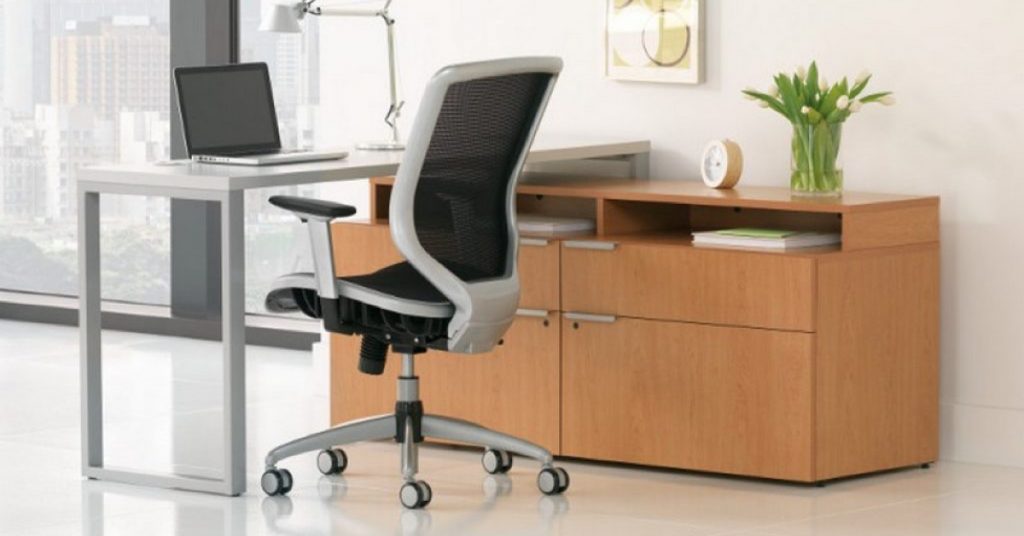Office Furniture Essentials for Small Businesses
July 31, 2019
In the Age of the Start-Up and Gig Economy, small companies comprising three to five people are on the rise. So how do you ensure everyone has the office essentials they need while not wasting money on extra space and furniture?
To provide your employees with a productive, functional, and comfortable work space no matter your business or office size, you’ll need to address a few essentials right away. Here’s how to design a productive small office that includes core items to meet everyone’s needs!
Determining Office Size
The general rule of thumb is to plan for 150 to 350 square feet per person. So, for a team of five, you’ll need about 750 to 1,750 square feet. Open space work stations require about 60 to 110 square feet per person. To factor in conference rooms and break areas, add another 50 to 75 square feet plus 25 square feet per person. Planning to expand in the next few years? It’s much easier to plan for your future now than be forced to find a new, larger office later!
The amount of space you need is also determined by the various roles of your employees. For example, a CEO may require a larger, separate office away from colleagues for privacy and confidentiality, while an account manager may be fine working in an open-office setting.
Remember, you know your team and their needs best! These guidelines may be enough to get you started, but you have the insight necessary to determine whether requirements such as extra large equipment or a large capacity conference room for outside clients are necessary.
Seating
Ergonomics is not a buzz word! Chairs need to be comfortable and versatile enough to meet multiple needs. Some team members may want a traditional formal desk chair while others need a perch stool or an ergonomic chair with all the bells and whistles. Bottom line: this isn’t your old-school, one-size-fits-all office seating. Accommodate your employees with seating that works for them and watch their productivity (and their contentment) soar!
Work Spaces
While conventional L-shaped desks can help save space by occupying a corner or being situated against a wall, sit-to-stand desks are aesthetic and ergonomic, as well as versatile and productive. If you choose to forgo traditional cubicles, you might want to opt for desk partitions instead. While they provide a moderate level of privacy, desk partitions aren’t confining in the way cubicles are, and they won’t inhibit general office discussions and communication.
Storage
Even if they primarily operate using digital technology, businesses still need to have a place for the paper they generate. Choose a central filing system that works for everyone, plus provide individuals with what they require for their specific needs. Your accountant or receptionist may need a large filing cabinet while your sales person needs only a minimum amount of storage space.
And don’t forget the shredder. Shredders are an absolute must for businesses that handle confidential documents on a regular basis!
Meeting Space
For a new twist on the traditional conference room setup, create a meeting space that serves multiple uses: team conferences, client meetings, and collaboration and brainstorming sessions for two or three people. A conference room that seats a team of five but accommodates up to 10 ensures adequate seating for special meetings that involve more than your core staff. Avoid that wasteland vibe by arranging chairs for your group at one end of a large table and fill in extra space with snacks, office essentials or a seasonal floral arrangement.
Break Room/Lunch Room
RIP boring old break room! Today’s employees want offices that offer inviting break areas for snacks and lunch. These rooms allow people to relax, take a brain break and build on relationships.
Staples like coffee and plastic cutlery should be a staple, don’t let it encroach on your style. Here are few ideas to get the most out of your small break room space:
- Go trendy with comfortable bistro-style chairs
- Use smaller tables to encourage socializing and collaboration
- Create a seating area away from the dining section for those looking to take a mental break without food
Special Accommodations
The modern workforce has become increasingly integrated with folks who have physical and intellectual disabilities. Making additional accommodations, such as wheel-chair accessibility, ergonomic furniture, extra space and other special modifications may be a wise choice. You don’t want to miss out on a great candidate because your office isn’t adequately equipped!
No matter how small your business may be, employees want to work for companies that offer modern office features like ergonomic seating, multi-use conference rooms, and inviting break areas. Employers, on the other hand, are eager to comply because it’s a win-win for the whole team!
Let the experts at Nolt’s help you design your office with the essentials you need to create a productive and enjoyable space! Stop by our showroom or give us a call today!
